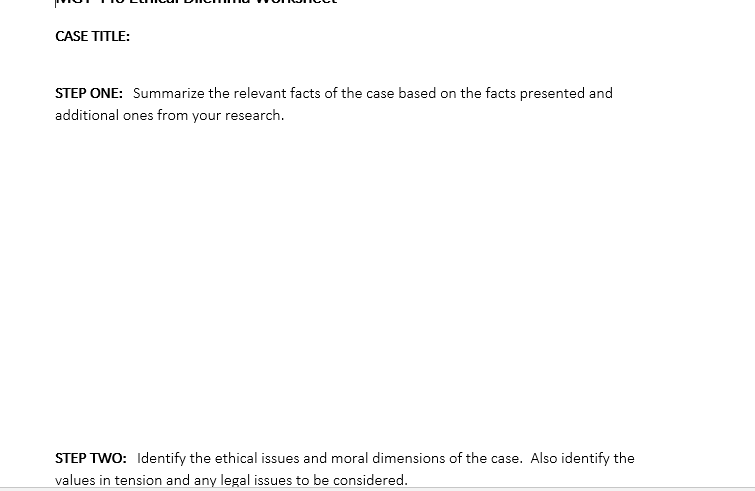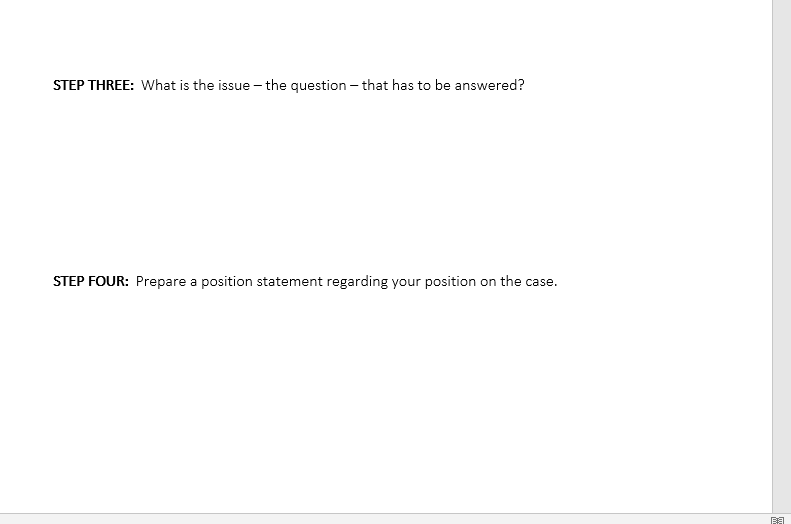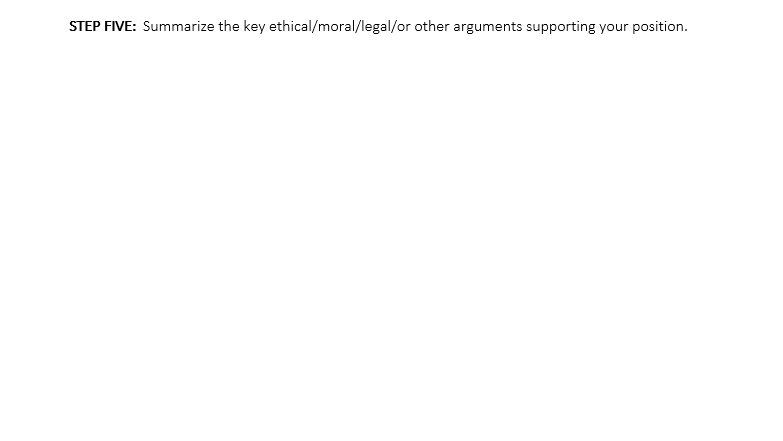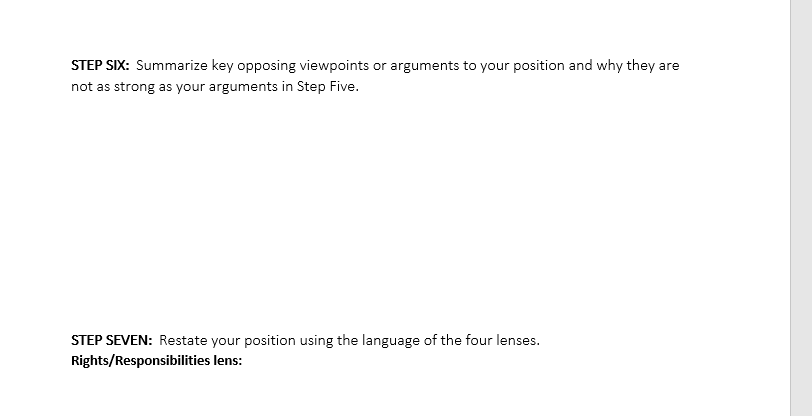I have a case, I want to do it as per word document pasted below. Pleae make sure there is no plagiriasm and need it atlest 5-7 pages on the case. Please follow the word document.



Below is the word document: the question of case is : Who should pay to clean up abadoned well?






1. Abandoned? Well, that's too bad The Rowe family is suing Blue Energy LLC for compensation regarding an incident that occurred in May 2012, although they say not even a million dollars would be sufficient for the horrors they endured. Reuters reported that "Hanson and Michael Rowe noticed an overpowering smell, like rotten eggs, seeping from an abandoned gas well on their land in Kentucky. The fumes made the retired couple feel nauseous, dizzy, and short of breath." 11 Unfortunately, the Rowes faced significant difficulty in holding the well's owner accountable. While the well was on their land, the well itself was owned and drilled by J.D. Carty Resources LLC in 2006. Carty dissolved in 2008 and sold the well to a company that was then acquired by Blue Energy, LLC, which denied any ownership or obligation for the well. The state of Kentucky declared the well an environmental emergency and ran a 40-day operation to plug it, while the Rowes moved to a trailer on their property with no running water. Regulators determined the leak was a toxic blend of hydrogen sulfide, a common drilling byproduct, and the potent greenhouse gas, methane. In last year's bipartisan infrastructure law, 4.7 billion dollars were provided to plug and remediate abandoned oil and gas wells. 2 There are anywhere from 750,000 to over 3 million abandoned oil and gas wells in the U.S. and they emit millions of metric tons of methane per year. In addition to climate impacts, they also can contaminate ground water and even pose safety hazards. And these wells are labor intensive and expensive to plug, costing anywhere between $76,000 to $1 million for each well 3. If you do the math, the funds set aside for fixing the issue are a good start but nowhere near sufficient to fully address the problem. In last year's bipartisan infrastructure law, 4.7 billion dollars were provided to plug and remediate abandoned oil and gas wells. 2 There are anywhere from 750,000 to over 3 million abandoned oil and gas wells in the U.S. and they emit millions of metric tons of methane per year. In addition to climate impacts, they also can contaminate ground water and even pose safety hazards. And these wells are labor intensive and expensive to plug, costing anywhere between $76,000 to $1 million for each well 3. If you do the math, the funds set aside for fixing the issue are a good start but nowhere near sufficient to fully address the problem. While the issue of abandoned wells has been pervasive for decades, our lawmakers have only begun to focus on remediation in the last few years. Many saw remediation of abandoned wells as politically popular because it could become a source of jobs in so called "energy transition communities" or areas where fossil fuel industry jobs dwindle as we transition to cleaner energy. And although the money will be put towards reducing emissions, something which we must do in order to reduce the most dire effects of climate change, some lawmakers have stated that the private companies who caused this problem should be footing the bill, not the federal government. Increasing bonding requirements for future well drilling could ensure that private companies put aside money in advance to deal with abandoned wells, but this would not address wells that have already been abandoned. Additionally, the money allocated in the bipartisan infrastructure law for remediation of abandoned wells will not solve the systemic problems that resulted in the abandonment of wells that emit methane, which would only accelerate with a transition away from fossil fuels. But, as made clear by the Rowe's situation, these abandoned wells are causing harm in communities, and the debate over who should pay would not have helped them live in a safe home. If there is political capital so to speak, many argue that the opportunity should be grabbed by the horns. 1. State your position 2. Additional relevant facts of the case based on your research 3. What are the values in tension and the moral dimensions of the case 4. Arguments (using the lenses) supporting your position 5. Opposing viewpoints (using the lenses) 6. Summarizing conclusion STEP ONE: Summarize the relevant facts of the case based on the facts presented and additional ones from your research. STEP TWO: Identify the ethical issues and moral dimensions of the case. Also identify the values in tension and any legal issues to be considered. STEP THREE: What is the issue - the question - that has to be answered? STEP FOUR: Prepare a position statement regarding your position on the case. STEP FIVE: Summarize the key ethical/moral/legal/or other arguments supporting your position. STEP SIX: Summarize key opposing viewpoints or arguments to your position and why they are not as strong as your arguments in Step Five. STEP SEVEN: Restate your position using the language of the four lenses. Rights/Responsibilities lens: STEP SEVEN: Restate your position using the language of the four lenses. Rights/Responsibilities lens: Results Lens: 1. Abandoned? Well, that's too bad The Rowe family is suing Blue Energy LLC for compensation regarding an incident that occurred in May 2012, although they say not even a million dollars would be sufficient for the horrors they endured. Reuters reported that "Hanson and Michael Rowe noticed an overpowering smell, like rotten eggs, seeping from an abandoned gas well on their land in Kentucky. The fumes made the retired couple feel nauseous, dizzy, and short of breath." 11 Unfortunately, the Rowes faced significant difficulty in holding the well's owner accountable. While the well was on their land, the well itself was owned and drilled by J.D. Carty Resources LLC in 2006. Carty dissolved in 2008 and sold the well to a company that was then acquired by Blue Energy, LLC, which denied any ownership or obligation for the well. The state of Kentucky declared the well an environmental emergency and ran a 40-day operation to plug it, while the Rowes moved to a trailer on their property with no running water. Regulators determined the leak was a toxic blend of hydrogen sulfide, a common drilling byproduct, and the potent greenhouse gas, methane. In last year's bipartisan infrastructure law, 4.7 billion dollars were provided to plug and remediate abandoned oil and gas wells. 2 There are anywhere from 750,000 to over 3 million abandoned oil and gas wells in the U.S. and they emit millions of metric tons of methane per year. In addition to climate impacts, they also can contaminate ground water and even pose safety hazards. And these wells are labor intensive and expensive to plug, costing anywhere between $76,000 to $1 million for each well 3. If you do the math, the funds set aside for fixing the issue are a good start but nowhere near sufficient to fully address the problem. In last year's bipartisan infrastructure law, 4.7 billion dollars were provided to plug and remediate abandoned oil and gas wells. 2 There are anywhere from 750,000 to over 3 million abandoned oil and gas wells in the U.S. and they emit millions of metric tons of methane per year. In addition to climate impacts, they also can contaminate ground water and even pose safety hazards. And these wells are labor intensive and expensive to plug, costing anywhere between $76,000 to $1 million for each well 3. If you do the math, the funds set aside for fixing the issue are a good start but nowhere near sufficient to fully address the problem. While the issue of abandoned wells has been pervasive for decades, our lawmakers have only begun to focus on remediation in the last few years. Many saw remediation of abandoned wells as politically popular because it could become a source of jobs in so called "energy transition communities" or areas where fossil fuel industry jobs dwindle as we transition to cleaner energy. And although the money will be put towards reducing emissions, something which we must do in order to reduce the most dire effects of climate change, some lawmakers have stated that the private companies who caused this problem should be footing the bill, not the federal government. Increasing bonding requirements for future well drilling could ensure that private companies put aside money in advance to deal with abandoned wells, but this would not address wells that have already been abandoned. Additionally, the money allocated in the bipartisan infrastructure law for remediation of abandoned wells will not solve the systemic problems that resulted in the abandonment of wells that emit methane, which would only accelerate with a transition away from fossil fuels. But, as made clear by the Rowe's situation, these abandoned wells are causing harm in communities, and the debate over who should pay would not have helped them live in a safe home. If there is political capital so to speak, many argue that the opportunity should be grabbed by the horns. 1. State your position 2. Additional relevant facts of the case based on your research 3. What are the values in tension and the moral dimensions of the case 4. Arguments (using the lenses) supporting your position 5. Opposing viewpoints (using the lenses) 6. Summarizing conclusion STEP ONE: Summarize the relevant facts of the case based on the facts presented and additional ones from your research. STEP TWO: Identify the ethical issues and moral dimensions of the case. Also identify the values in tension and any legal issues to be considered. STEP THREE: What is the issue - the question - that has to be answered? STEP FOUR: Prepare a position statement regarding your position on the case. STEP FIVE: Summarize the key ethical/moral/legal/or other arguments supporting your position. STEP SIX: Summarize key opposing viewpoints or arguments to your position and why they are not as strong as your arguments in Step Five. STEP SEVEN: Restate your position using the language of the four lenses. Rights/Responsibilities lens: STEP SEVEN: Restate your position using the language of the four lenses. Rights/Responsibilities lens: Results Lens















